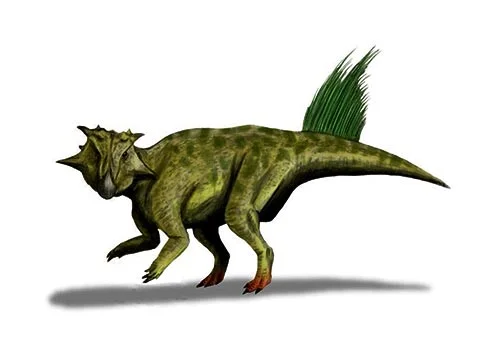Psittacosaurus (Parrot lizard)

Sit-tah-coe-sore-us
Henry Fairfield Osborn – 1923
Herbivore
Estimated 2 meters long
Ceratopsian
P. mongoliensis (type)
China, Mongolia and Russia. Possibly also Thailand
Early Cretaceous, 120 million years ago
Psittacosaurus Facts
Psittacosaurus, meaning “parrot lizard,” is a genus of small, herbivorous dinosaur that lived during the Early Cretaceous period, approximately 120 million years ago. It was a member of the group known as ceratopsians, which were characterized by their large, bony frills and horns on their faces.
Psittacosaurus was first discovered in China during the early 1900s and has since become one of the most well-known dinosaurs from this region. Many specimens of Psittacosaurus have been found, ranging in size from hatchlings to adults, providing valuable insights into the growth and development of this dinosaur.
Psittacosaurus was a small dinosaur, measuring up to 2 meters (6.5 feet) in length and weighing up to 50 kilograms (110 pounds). It had a relatively short, sturdy body with four legs and a long, slender tail. Its most distinctive feature was its head, which had a parrot-like beak and a row of small, leaf-shaped teeth for grinding vegetation.
Psittacosaurus also had a large, broad frill on its neck, which likely served as a display structure for communication and courtship. Some specimens also had small horns or spikes on the frill or above the eyes, although these were much smaller than the horns of later ceratopsians.
Psittacosaurus likely fed on a variety of vegetation, including ferns, cycads, and flowering plants. Its powerful jaws and hundreds of closely packed teeth would have allowed it to grind tough plant material efficiently.
One of the most interesting aspects of Psittacosaurus is its remarkable growth and development. By studying the growth rings in the bones of different specimens, paleontologists have been able to reconstruct the growth rates and life stages of this dinosaur. They have found that Psittacosaurus grew very quickly during its early life, doubling in size in just a few years, and reaching sexual maturity at a relatively young age. This rapid growth may have been an adaptation to the high levels of predation in the ecosystem, allowing young dinosaurs to reach a size where they could better defend themselves.



